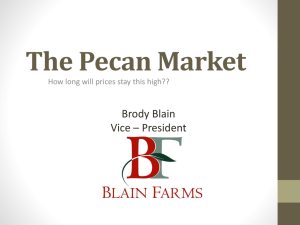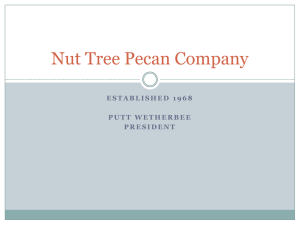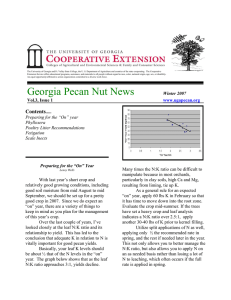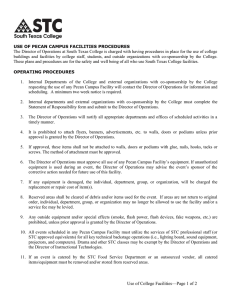CI-IAPACTIEPISTICS AND ITS MANY USES \931:ZA,4? July 1927
advertisement
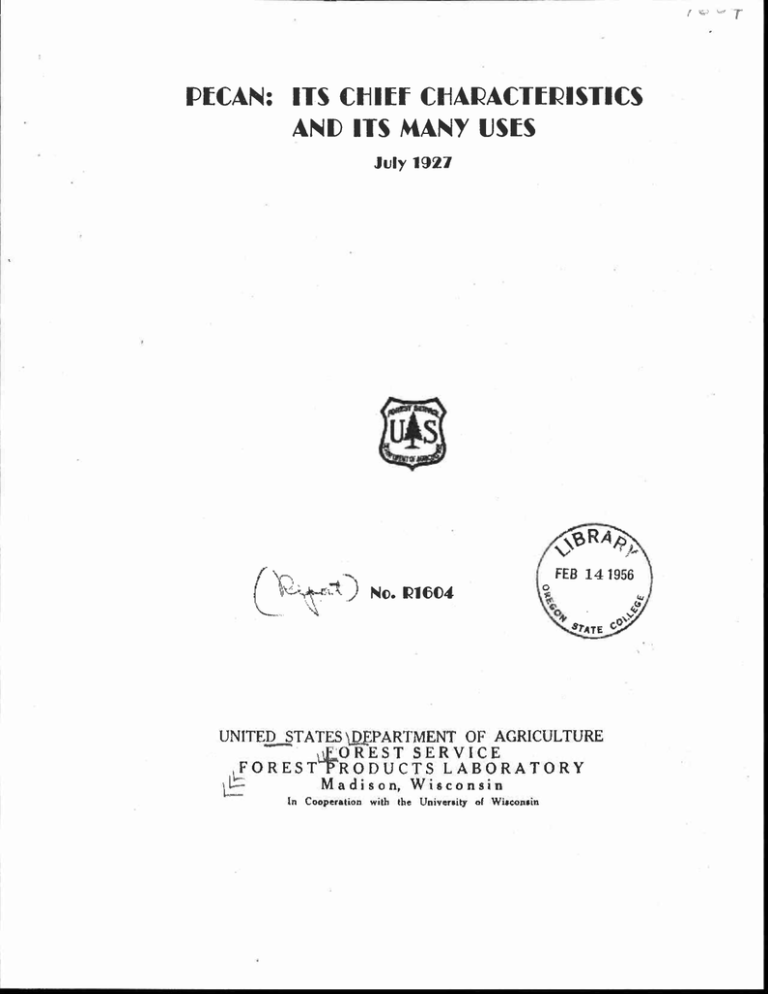
tc,d PECAN: ITS WEE CI-IAPACTIEPISTICS AND ITS MANY USES July 1927 \931:ZA,4? FEB 1 4 1956 No. 121604 q 8rATE UNITED STATESTEPARTMENT OF AGRICULTURE OREST SERVICE ,FOREST —PRODUCTS LABORATORY Madison, Wisconsin In Cooperation with the University of Wisconsin T PECAN; ITS CHIEF CHARACTERISTICS AND ITS MANY USES' By G. C. MORRECK, Wood Technologist The pecans and the true hickories are kindred species. In fact, the relation&lip is so close that all bear a common botanical name, Hicoria. The wood of the pecan, however, though quite similar to hickory in appearance, is somewhat different in properties; and because certain classes of hardwood consumers have persisted and to some extent still persist in comparing it with true hickory, it has acquired a reputation in the lumber'trade far below its merits. True hickory is heavy, hard, strong, stiff, and very tough. No commercially important species growing anywhere in the world combines these properties in so great a degree. That the pecans should measure up to a wood of that character need hardly be expected. Nevertheless, in a somewhat reduced degree, the wood of the pecans is also heavy, hard, strong, stiff, and tough, being as good in these respects, , or actually excelling many of our better-known hardwoods, such as maple, birch, oak and ash. Sold Under Other Names Very little pecan was sold under its own name in lumber or other forms prior to the entry of America into the World War. The bulk of the wood that reached the consumer was of the highest grades and found its way into commercial channels in mixture with the true hickories. Just how extensive was the mixing of species can only be conjectured. Pecan lumber so closely resembles that of the true hickories that no attempt is ordinarily made to separate the species in inspecting a lot of lumber known to be mixed. The practice of mixing has proved unfortunate for pecan, since that wood has been made the scapegoat for all poor performance in mixed lots of material. The first Government estimates of the production of pecan were made for the year 1913. The reported cut of about one million feet was undoubtedly much less than actually produced, because of the large proportion marketed as hickory. Statistics for the years following show no –Published in Memphis Lumberman, July 1927. Report No. 81604 -1- increase in pecan production until 1917. During the war the species became quite firmly established in the trade, and by 1924 the reported annual cut of pecan exceeded five million feet. There are five distinct species in the pecan group of hickories -the sweet pecan, two species locally known as bitter pecan, the nutmeg hickory, and the bitternut. Sweet pecan (Hicoria pecan) and one of the two bitter pecans (Hicoria aquatics) are found in considerable quantities in certain hardwood stands in the South, and these two species provide practically all the commercial pecan in lumber or other forms. The commercial range of sweet pecan is confined largely to ridges in the alluvial areas along the Mississippi and its tributaries from Southern Illinois to South Central Louisiana, and in Eastern Texas. The best stands of the species are probably found in the St. Francis and White River basins in Arkansas, and in northeastern Louisiana. Sweet pecan does not grow in pure stands but is found associated with red gum, hickory, caw oak, forked leaf whtte oak, red oak, locally ! known as yellow-butt and cherry-bark, and smooth-bark pin oak. It is seldom absent from the alluvial ridges, but almost never comprises more than one-fifth to one-fourth of the stand on areas of 100 acres or less. Over larger areas, even in regions of its best development, sweet pecan seldom exceeds 500 to 600 feet, b.m., per acre, and probably constitutes less than 10 percent of the total value of timber of commercial size. Bitter pecan, or water hickory as it is often called, is a moistureloving species. The tree is of commercial importance only in Louisiana and the alluvial regions immediately adjacent. Unlike sweet pecan, it thrives best in swamps subject to overflows that may cover the ground for months at a time. It is almost always associated with overcup oak. There are rather large areas where these two species constitute the only timber on the land. The most extensive body of bitter pecan and one in which the species occurs in most nearly pure stands is in east central Louisiana. The center of this area is near the confluence of the Black and Red Rivers. A second, less extensive tract, is found in the Yazoo Basin north of Vicksburg, Mississippi. There are also large bodies of bitter pecan on low flat lands along every river flowing into the alluvial valley of the Mississippi. Bitter pecan occurs in stands of 1,000 to 6,000 feet per acre, and timber of this density can be found in large tracts. The species growing under favorable conditions nearly always comprises at. least 20 percent of the commercial timber stand, and under the best conditions the proportion may run as high as 50 or even 60 percent of the total volume. In the pecan group the nuts are usually thin shelled and thin husked, and the leaves have from 7 to 15 comparatively narrow leaflets. The bark is only moderately scaly. In the true hickories the nuts are generally hard-shelled and thick husked, the leaves have from 3 to 9 leaflets, and the bark is commonly quite scaly. Report No. 81604 -2- Of the pecans, the true_ pecan, or sweet pecan, is the largest and most important. Trees of this species 170 feet in height awl from 5 to 6 feet in diameter have been recorded. Distinguishing characteristics of the sweet pecan are leaves with 9 to 11 slender leaflets and elongated edible nuts about one inch in length, with thin ridged husks and thin, brown} bony shells. The bark is dark brown in color, close, and finely ridged. Bitter pecan bears a strong resemblance to sweet pecan, especially in the buds, twigs, and leaves. The bark, however, is more scaly and is light gray in color. The nut will readily distinguish it from true hickory or sweet pecan. It is flattened, often sharply angled, and the kenel is very bitter. The bitter pecan is generally a small tree and seldom reaches a diameter of more than two feet, though it frequently forms a long, clear bole. The hickories, except for bitter pecan (Hicoria aquatica), are distinctly "ring-porous" woods. That is, the gTOWEE-Fings show distinct layer's of large pores in that part of the wood laid on at the beginning of the growing season. In the true hickories the pores formed in the summer are very much smaller, than the spring pores, and the line of demarcation between them is rather abrupt. No constant characters of the wood have been found by which the various species of true hickory can be separated with any degree of certainty. So far as present knowledge ems, the pecans, except bitter pecan, cannot be separated from the true hickories on the basis of structural characters or on general appearance of the wood. Bitter pecan can be quite readily differentiated, however, by the very indefinite rings of large spring pores and by the prevalence of pores only slightly smaller in the summerwood. The wood in cross-section is very similar to that of "diffuse-porous" species, in which the pores are usually quite uniform in size and in distribution throughout the entire growth ring. In structure, bitter peean somewhat resembles black walnut, for which it is quite often substituted. In contrast to bitter pecan, sweet pecan has large spring pores that occur in a rather wide band; the pores produced later in the season taper off gradually in size until growth ceases for the year. The common practice among Southern hardwood operators who log pecan timber is to remove only 40 to 50 percent of the pecan stumpage of merchantable size. Pecan trees above 26 inches in diameter are usually defective and comprise the bulk of the material left. It is commonly con sidered undesirable to cut pecan in summer, since both logs and lumber are likely to split badly through over-rapid drying during the hot season unless very carefully handled. The defective character of pecan stumpage is largely responsible for the low percentage of timber logged. Despite the fact that choice is exercised in the woods, the lumber produced is of low average grade. Very rarely does the-volume of Firsts and seconds, regardless of the relatively Report N IPA R1604 .3. low quality required of the mill-run yield. No. Common and No. 3 Common character that they can the species in this grade, exceed 15 percent of 1 Common comprises 40 to 50 percent, No. 2 the remainder. The latter two grades are of such he disposed of only with some difficulty. Types of defects in the timber cut are very similar to those which occur in hickory. There is probably less "bird peck" in pecan, but there is considerably more shake. Mineral streaks and brown spots are about equally prevalent in the two species. The general impression among lumbermen is that sweet pecan is some what better, in most repects than the bitter species and yields a larger proportion of upper grades. The prevalence of wind shake in bitter pecan accounts very largely for the excessive waste in logging that wood. Much of the shake in both woods is exceedingly fine and cannot be detected in the freshly cut logs or boards, and occasionally not even in lumber ready for shipment. 'The latter characteristic is partly responsible for occasional complaints that stock apparently clear when cut to rough size for factory use develops serious defects during the machining processes. The 'most common defects revealed are shake, bark pockets, and "bird pecks." The shake often does not appear until the wood is far along in the process of fabrication, giving the pieces affected the appearance of being more or less season checked. The density of commercial pecan is 0,59, as compared with 0.65 for hickory. The sapwood is white and relatively thick. The heartwood is dark, with a decided reddish hue. The numerous large pores, especially in bitter pecan, give the wood a rather coarse appearance. The working qualities of pecan are good, and generally reputed to be equal to or better than those of the true hickories. The wood turns well in a lathe with little splintering, and takes an excellent finish. Pecan seasons with more or less difficulty both in the yard and in the kiln. Those familiar with the wood generally hold that it splits and checks somewhat more readily than oak or hickory both in air seasoning and in kiln drying. Some users of thick pecan, however, prefer this wood to oak because they can dry it to a usable condition in 20 to 25 percent less time than would be required for oak of the same thickness. A few factories accustomed to using chiefly the softer species of hardwoods have claimed that pecan does not finish well, dulls knives in the wood-working machines, and slows up factory operations. Such objections, however, are not serious at plants equipped for working oak, ash, maple, and other woods of similar hardness. Auto truck factories using thick material report no difficulties in machining pecan for body use. Pecan holds nails and screws well. The wood, however, does not glue as readily as some other species, but no serious difficulties should be encountered in gluing operations. In cormion with the other hickories, Report No. 81604 -4- pecan is of only medium durability when placed in positions favorable to decay. In this respect it is about equal to white ash, and is somewhat superior to sugar maple and birch. The strength and other mechanical properties of commercial pecan are all somewhat under those of the true hickories. The best pecan, however, will have values equal to or in excess of those for the average hickory and may be used interchangeably with hickory for the most exacting uses. The following table shows pecan in comparison with true hickory and three other common hardwoods, pecan being taken as 100 except in the ca g e of specific gravity, where actual values are shown: Species : :Shrinkage : :Specific:(in volume,:Strength: : :from green : as beam: Hard:gravity :to oven-dry: or post: ness : :condition) : 4 Hickory : Commercial : white ash : 4 : 133 : 111 :. . • 141 114 : 100 : : : • 100 : 100 : 100 100 .59 : 113 : 81 : : 77 : 61 90 • : 93 : 81 : 66 108 : : 91 : - 78 : 68 98 .65 : COMYERCIAL : PECAN.59 Commercial white oak : : ugar maple : S : Shock : :resisting: : ability : Stiffness . or : :toughness: .57 : 108 : .54 : 92 : : : : : 1 It will be seen from this tabulation that pecan has higher strengthvalues in every property noted (stiffness in maple excepted) than any of the woods below it, and smaller shrinkage than any in the list except Idaite ash. In some uses where extreme toughness is not a determining factor, pecan is and will probably continue to be substituted for hickory. It is used successfully ['or small handles of all kinds and other turned articles, particularly where hardness is important. Report No. R1601 -5- For years pecan has been used in buggy manufacture for gear wood, especially for head blocks and axle caps. It is also used as a substitute for oak and hickory in wagon-nuking. Pecan is not considered suitable by some manufacturers for standard automobile spokes because of the work involved in eliminating the weaker pieces. Carefully selected pecan has been used for. this purpose, however, with satisfactory results. Pecan spokes are probably superior to those of maple and oak, both of which are sometimes used for wheel.work. Thick pecan is used quite extensively in the construction of auto truck bodies, in which use it gives very good service. It replaces maple, oak, and ash for parts where hardness, strength and toughness are required. Pecan is used to some extent in passenger automobiles, and manufacturers report the wood satisfactory except that it is harder than other woods commonly employed in body work, and production of parts is somewhat slowed up. It is particularly useful for posts and pillars where material is cut away to take locks or hinges. Furniture and chair factories consume considerable quantities of ,pecan. In these industries the wood replaces walnut and mahogany in the cheaper commodities. It is also used where the design requires slender parts and a high degree of hardness and strength in the sizes desired. In chair work the stretchers, run7s, rocker runners, and spindles are quite commonly of pecan. In case goods pecan is coming into increased use for interiors and as finish material to imitate more expensive woods. Five-ply veneer is sometimes made with pecan cores, especially where a walnut or mahogany finish is to be applied to the exposed edges. Sewing machine cabinets -- particularly those intended for export -are frequently made of pecan. For this purpose bitter pecan and sweet pecan are taken without discrimination. Pecan is useful in bent work, particularly where the curvature is not severe. Top slats in office chairs are often of pecan bent to shape and finished to imitate mahogany. Another common use for pecan is in the wooden structure of agricultural machinery as a substitute for oak when the latter i4 high in price. Minor uses, such as interior trim, slack cooperage, and meat pegs, account for a certain quantity of the wood. An outlet for low grades and waste is found in the use of pecan as smoke-fuel in the curing of meat. Outlets for pecan to the full extent of the production of the wood in normal lumbering operations can best be secured by expanding present markets. The principal uses for pecan can readily consume the whole output, at least in those grades that meet their needs. The problem of utilizing pecan can thus be somewhat simplified. Re p ort No. R1604 -6- The broader utilization of pecan should be based chiefly on two factors -- density and appearance. Dense pecan should be used interchangeably with hickory, the properties of such material being quite equal to those of average pieces of true hickory. Pecan of medium quality can be used instead of hickory wherever extreme toughness is not required in use. Light pecan is often brash and is unreliable where strength is essential. Where appearance is an important factor, strength, hardness, and toughness may or may not also be prime requisites. In ordinary case and cabinet furniture construction lightweight pecan makes up attractively and is generally suitable from the standpoint of physical and mechanical properties. For the matching of walnut and mahogany such material may actually be superior to denser stock. For chair parts, where strength and some degree of resiliency are essential, dense pecan is to be preferred. In particular, slender spindles, rungs, and posts must be of dense stock to withstand the service required. The fact that pecan wood can be finished to resemble walnut or mahogany very closely increases the possibility of extended outlets in this field. Pecan of the proper density can be substituted for oak, birch, and maple for many uses, especially where strength, hardness and toughness are essential. A most likely outlet for pecan in increased quantities is in the automobile truck body industry, already mentioned. The wood is giving very good service in the various uses to which it is put in truck building. The dimensions used are usually two inches and thicker and the grades No. 1 Common and Better. Dense pecan should be satisfactory for pick sledge, axe, and similar handles now generally made of hickory. The comparatively large cross-sectional areas of handles of these types insure a margin of strength and toughness which will probably be adequate to the requirements of service. Resistance to decay is usually not an important factor in such products, and, in any event, pecans and hickories are about equal in that respect. Where oak, maple, and ash are suitable for handles, pecan can undoubtedly be substituted for any of the three with the assurance that its service will be equal to, or greater than, that of the wood for which it is substituted. Only where resistance to decay is a factor would an exception have to be made in favor of white oak, since pecan is considerably less durable than that wood. The use of pecan can be extended in the furniture industry by employing it more generally for turned parts and for purposes where the wood is not exposed. The latter use will provide outlets for the lower grades and suitable defective stock which would otherwise be wasted. In fact, all classes of pecan can be more widely utilized in the furniture industry, since the material is used in some positions because of its strength and in others because of its good finishing qualities. The use of pecan for light bending purposes can also undoubtedly be considerably extended. Report No. R1604 -7- Owing to the relatively large proportion of defective material in standing pecan, utilization of the stumpage can be greatly augmented by converting the timber directly into rough dimension stock. The problems involved in the manufacture of pecan dimension should be little, if at all, different from those encountered with hickory. The difficulties in hickory dimension production have been largely overcome, and experience already gained in such work will serve as an excellent basis on which to attack any new problems arising with pecan dimension.. Outlets for pecan dimension stock will be much the same as for pecan lumber. Some stock will also be made into turning squares for production of articles in substitution for hickory. Great care must be exercised, however, in the selection of material for the uses intended. Nothing will discredit pecan so thoroughly as to market it for purposes to which it is not adapted. Such practice should be vigorously opposed if pecan is to attain its proper place among our important commercial hardwoods. Acknowledgement is made of valuable information furnished by various producers and consumers of pecan lumber, and particularly by Mr. C. D. Shy of H. E. Spain & Co., Memphis, Tennessee, in the study here presented. Report Mo. 11604 -8-

